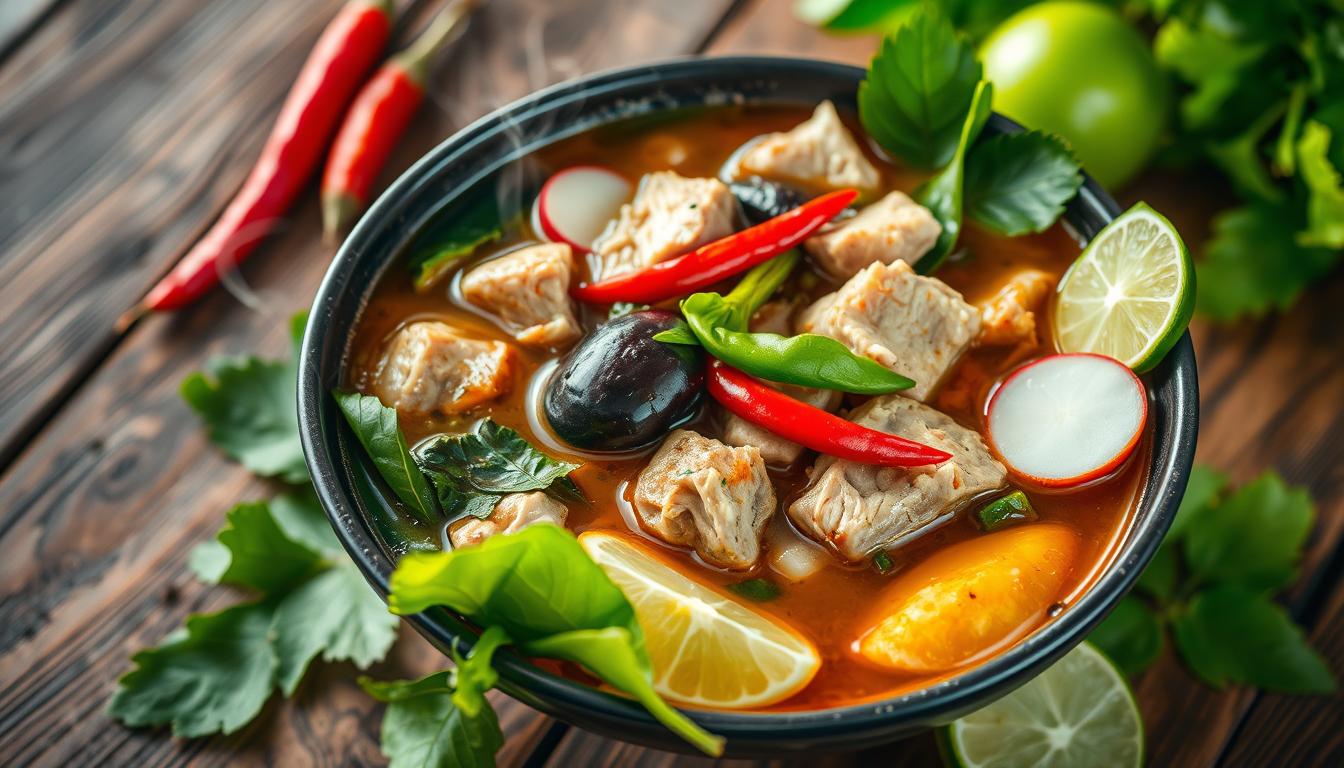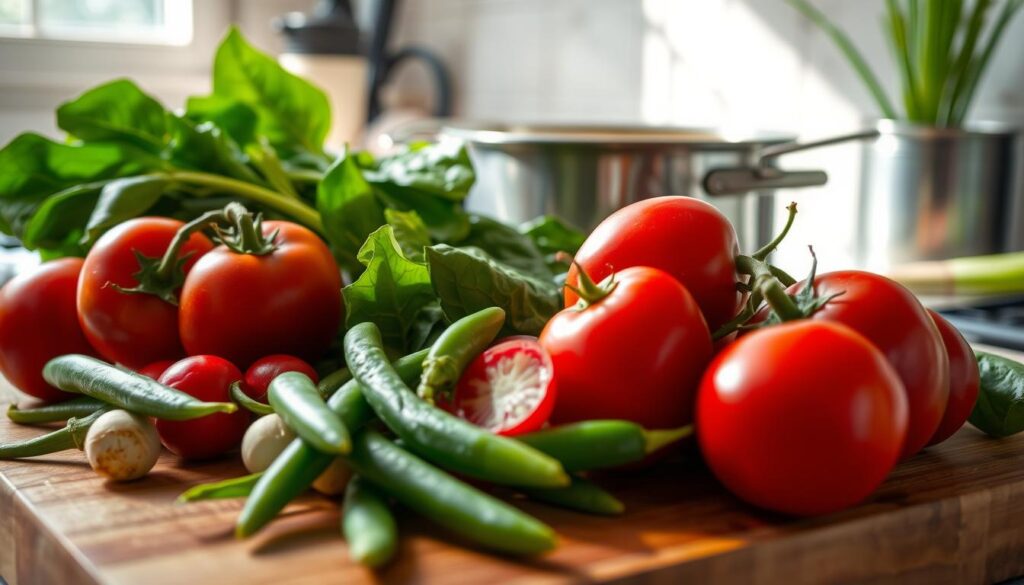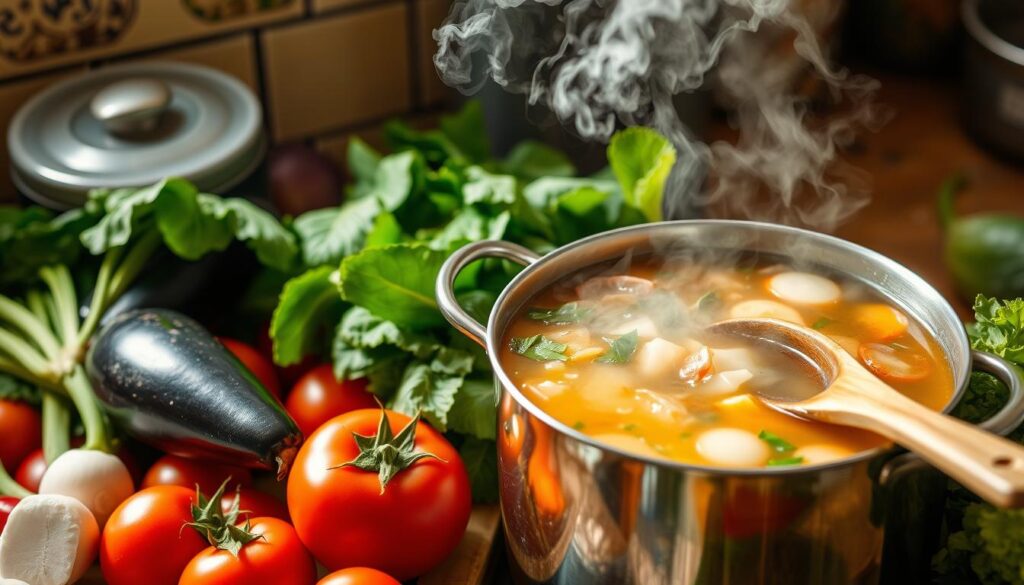How to Make Authentic Filipino Sinigang Recipe
Growing up in a Filipino-American home, the smell of sinigang recipe took me back to my grandma’s kitchen. This Filipino sour soup was more than food. It was a warm hug of tradition, memories, and comfort that tied me to my roots.
The secret to a great sinigang recipe is its mix of tangy, savory, and satisfying flavors. Whether you’re exploring new recipes or reconnecting with Filipino food, this tamarind broth dish is unforgettable.
In this guide, you’ll learn to make a real sinigang recipe that feels like home. We’ll cover picking the right ingredients and mastering the cooking method. You’ll get to make this beloved comfort food yourself.
Ready to turn your kitchen into a piece of the Philippines? Start your culinary adventure with sinigang recipe today!
What is Sinigang and Its Cultural Significance?
Sinigang recipe is more than a simple soup; it’s a key part of Filipino cuisine. It shows the rich history of the Philippines through its flavors. These flavors tell stories of culture and community.
The cultural value of sinigang is deep in Filipino traditions. It’s a comfort food that unites families. They gather around a pot of tangy, savory goodness.
Origins of Sinigang recipe
The name “sinigang” comes from “sigang,” meaning to stew. This tradition goes back generations. It shows how Filipino cooks turned simple ingredients into amazing meals.
- Originated in the Philippine archipelago
- Developed as a practical one-pot meal
- Showcases the resourcefulness of Filipino cooking
Regional Variations
Every Filipino region has its own sinigang twist. From coast to mountains, local ingredients make the dish unique.
- Sinigang na hipon: Shrimp-based variation
- Sinigang na baboy: Pork-centered version
- Seafood and vegetable combinations unique to specific regions
Importance in Filipino Cuisine
“Sinigang is more than food; it’s a celebration of Filipino identity on a plate.” – Filipino Culinary Expert
Sinigang has become famous worldwide. TasteAtlas named it the best vegetable soup in 2021. It introduces people to the rich flavors of Filipino cooking.
Sinigang is enjoyed in rainy seasons and at celebrations. It shows the warmth and hospitality of Filipino traditions.
Key Ingredients for a Flavorful Sinigang recipe
To make a true Filipino sour soup, you need to know the key ingredients. These ingredients add depth and character to the dish. They turn a simple soup into a memorable meal.
Protein Selection for Sinigang recipe
There’s a wide range of proteins to choose from for Filipino sour soup. Your main options are:
- Pork (belly, spare ribs)
- Chicken
- Seafood options:
- Salmon
- Shrimp
- Pompano
Essential Vegetables
Vegetables are key to sinigang’s flavor. Traditional ingredients include:
- Leafy greens (bok choy, kang kong, spinach)
- Root vegetables (daikon radish)
- Other vegetables:
- Okra
- Tomatoes
- Onions
Souring Agents
The tangy flavor of sinigang comes from souring agents. Tamarind is the most traditional choice. But you can also try:
- Tamarind paste (primary souring agent)
- Alternative souring fruits:
- Guava
- Green mango
- Pineapple
“The magic of sinigang lies in balancing its sour notes with fresh, vibrant ingredients.”
Choosing the right ingredients can make sinigang your own. It lets you be creative while keeping it true to its roots.
Preparing Your Ingredients for Sinigang
Making a real sinigang recipe needs careful ingredient prep. Your success in making this classic Filipino soup depends on how well you pick and prepare your ingredients.
Professional chefs say proper prep is key to a great sinigang. How you choose and clean your ingredients will affect the dish’s taste and quality.
Meat and Seafood Selection
Here are some tips for preparing meat for sinigang:
- Choose fatty cuts like pork belly for rich flavor
- Select bone-in pieces for enhanced taste profile
- Cut meat into uniform 1-2 inch cubes
- Trim excess fat but retain some for depth
Vegetable Preparation Techniques
Vegetable prep is key in sinigang recipe prep. Follow these steps:
- Wash all vegetables thoroughly under cold water
- Cut vegetables into consistent sizes for even cooking
- Remove stems from leafy greens like kangkong
- Slice harder vegetables like radish and eggplant into bite-sized pieces
“The secret to a perfect sinigang lies in the details of ingredient preparation.” – Filipino Culinary Tradition
For seafood, check for freshness by looking at clear eyes, firm flesh, and a clean scent. Always clean and devein shrimp or fish before adding to your sinigang.
Souring Agent Preparation
Your souring agent gives sinigang its tangy flavor. Use fresh tamarind pulp or premade mix. Strain carefully to get the most flavor without pulp or seeds.
Choosing the Right Cooking Method
Learning to make sinigang is all about mastering different cooking techniques. Each method has its own benefits for making this beloved Filipino dish.
Traditional Stovetop Technique
The classic way to make Filipino soup is on the stovetop. This method lets you control the flavors and timing of ingredients. Here’s how you do it:
- Sear meat to lock in flavors
- Add liquid and create base broth
- Incorporate vegetables sequentially
- Adjust seasoning gradually
Instant Pot Sinigang recipe
Using the Instant Pot is a modern twist on sinigang. It cuts down cooking time without losing flavor. Pressure cooking makes meat tender faster and cooks everything quicker.
Slow Cooker Options
Slow cookers are great for a no-fuss approach. They let ingredients simmer for hours, creating deep, rich flavors.
| Cooking Method | Cooking Time | Flavor Intensity |
|---|---|---|
| Stovetop | 60-75 minutes | High |
| Instant Pot | 30-45 minutes | Medium-High |
| Slow Cooker | 4-6 hours | Very High |
“The secret to perfect sinigang lies not just in ingredients, but in the cooking method you choose.” – Filipino Culinary Experts
The Step-by-Step Sinigang Cooking Process
Learning to make sinigang takes patience and focus. This Filipino sour soup mixes flavors that take you to the Philippines.
Crafting the Flavorful Broth: sinigang recipe
Begin by making a strong base. Traditional steps include:
- Sauté minced garlic and chopped onions in a large pot
- Add fresh tomatoes for extra depth
- Pour 2 quarts of water into the pot
- Introduce tamarind paste or fresh tamarind pods
Selecting and Preparing Proteins: sinigang recipe
Choosing the right protein is key. Pork belly is the top pick, needing about 2 lbs for a basic recipe.
| Protein Options | Cooking Time |
|---|---|
| Pork Belly | 25-30 minutes |
| Shrimp | 5-7 minutes |
| Chicken | 20-25 minutes |
Vegetable Integration: sinigang recipe
Vegetables should be added at the right time. Begin with hard veggies like daikon radish and finish with soft greens like kangkong.
“The secret to perfect sinigang lies in understanding each ingredient’s cooking rhythm.” – Filipino Culinary Tradition
Perfecting the Signature Sourness
Find the right balance of sourness by trying different souring agents. Tamarind is classic, but guava or green mango can add a new twist.
- Taste and adjust sourness gradually
- Use fish sauce for seasoning
- Add salt to enhance overall flavor
The whole sinigang process takes 45 to 90 minutes. This depends on your protein choice and flavor level.
Tips for Enhancing Your Sinigang
To make your sinigang better, think creatively and learn about different Filipino soup styles. This traditional dish is full of chances to add new flavors. It can change how you enjoy cooking and eating.
Customizing Your Spice Level: sinigang recipe
Try different peppers to change the heat level. Thai chilies give a strong kick, while jalapeños add a gentle warmth. It’s all about what you like.
- Thai chilies for intense heat
- Jalapeños for mild warmth
- Serrano peppers for medium spiciness
Exploring Souring Agents: sinigang recipe
While tamarind is the usual souring agent, you can try other things. Guava, green mangoes, and calamansi can add new tangy flavors to your sinigang.
“The magic of sinigang lies in its ability to balance sourness with rich, complex flavors.” – Filipino Culinary Expert
Enhancing with Herbs and Spices: sinigang recipe
Fresh herbs can really make your sinigang better. Lemongrass adds a nice aroma, and ginger brings warmth and depth. Try fresh cilantro or mint for something different.
- Lemongrass for aromatic notes
- Ginger for warmth
- Fresh herbs for brightness
Remember, sinigang is a dish you can make your own. Feel free to try new things and make it special!
Serving Suggestions for Sinigang
Presenting sinigang is an art that turns this traditional Filipino soup into a culinary experience. Your sinigang serving ideas can make the dish special and impress your guests. They will love the authentic Filipino soup presentation.
When serving sinigang, keep these presentation tips in mind. They capture the essence of Filipino dining culture:
Ideal Sides to Complement Your Sinigang
- Steamed jasmine rice (the classic accompaniment)
- Crispy tuyo (dried fish) for added texture
- Small dish of patis (fish sauce) with crushed chili peppers
Plating and Presentation Techniques: sinigang recipe
Make your sinigang look stunning with these professional serving suggestions:
- Use a large, deep ceramic bowl to showcase the soup
- Arrange meat and vegetables strategically for visual appeal
- Garnish with fresh herbs like cilantro or green onions
“A well-presented sinigang is not just a meal, it’s a celebration of Filipino culinary traditions.”
Temperature and Serving Recommendations: sinigang recipe
| Serving Aspect | Recommended Approach |
|---|---|
| Serving Temperature | Piping hot, straight from the pot |
| Portion Size | 1-2 cups per person with rice |
| Best Served | Immediately after cooking |
Your sinigang serving ideas can turn an ordinary meal into an extraordinary dining experience. It honors Filipino culinary traditions.
Common Mistakes to Avoid in Sinigang Preparation
Learning to make sinigang well means knowing what can go wrong. Even skilled cooks can mess up, ruining the dish’s taste and feel. This is a beloved Filipino soup.
Most mistakes come from not handling ingredients right or balancing flavors. We’ll look at the top errors that can turn your sinigang into a letdown.
Ingredient Overcooking Risks: sinigang recipe
- Avoid overcooking vegetables, especially delicate greens like kangkong
- Add leafy vegetables during the final minutes of cooking
- Maintain vegetable crispness and vibrant colors
- Prevent mushy textures that ruin the soup’s appeal
Flavor Balance Challenges: sinigang recipe
Getting the sinigang flavor just right is key. Start with a little tamarind and add more as needed to avoid too much sourness.
| Mistake | Solution |
|---|---|
| Oversourcing | Add tamarind gradually, taste frequently |
| Excessive Fish Sauce | Use sparingly to prevent overpowering flavors |
| Meat Preparation | Sear meat first to develop deeper flavor profiles |
“The secret to great sinigang lies not just in ingredients, but in understanding their delicate interactions.” – Filipino Culinary Experts
By steering clear of these common mistakes, you’ll make a sinigang that’s true to its Filipino roots. It will be a dish that’s both authentic and tasty.
Storing and Reheating Leftover Sinigang
Keeping your sinigang leftovers tasty is all about planning. Store it in an airtight container to enjoy it for 2-3 days in the fridge. The flavors of sinigang get even better as the ingredients mix together, making it great for meal prep.
Reheating sinigang can be done in a few ways to keep its taste true. The stovetop is best for warming it up gently, keeping the veggies tender. If you use a microwave, cover it and heat for two minutes, checking it often. Make sure it’s hot all the way through for safety and flavor.
Best Practices for Storage
To keep sinigang moist, add a bit of water when reheating. Tamarind’s acidity helps keep it fresh, but proper storage is key. Use Ziplock bags for freezer storage, and it can last up to 3 months. Freezing just the broth and meat is a good idea, adding fresh veggies when you serve for the best taste and texture.
Reheating Tips for Maximum Flavor
Reheating your sinigang leftovers can make them even better. Try grilling or heating it over an open fire for a smoky flavor. Remember, the right storage and gentle reheating are essential to keep sinigang’s authentic taste.
FAQ
What is the main souring agent in traditional sinigang?
Tamarind is the key souring agent in sinigang. Fresh tamarind pulp is often used. But, tamarind paste is a good substitute for home cooks.
Can I make sinigang with different types of protein?
Yes, you can! Sinigang works well with many proteins like pork, chicken, beef, fish, or shrimp. Each adds a special flavor to the sour soup.
Are there alternative souring agents besides tamarind?
Yes, you can use other souring agents. Guava, bilimbi, green mango, pineapple, or santol can give a similar tangy taste.
How long does it take to cook sinigang?
Cooking sinigang takes 45-90 minutes. The time depends on the protein used. Meat like pork belly takes longer than seafood.
Can sinigang be stored and reheated?
You can store sinigang in an airtight container in the fridge for up to a week. Reheat it gently to keep the veggies tender. Add fresh greens when reheating for the best texture.
Is sinigang spicy?
Traditional sinigang isn’t spicy. But, you can add Thai chilies or hot peppers to make it spicier.
What is the best way to serve sinigang?
Serve sinigang hot with steamed jasmine rice. Offer fish sauce and crushed chili peppers on the side. Garnish with fresh herbs like cilantro or green onions for extra flavor and looks.
Can vegetarians enjoy sinigang?
Yes! Vegetarians can enjoy sinigang by leaving out the meat. Use a variety of veggies like eggplant, okra, and daikon radish. The sour broth and flavorful veggies make it tasty for vegetarians.











